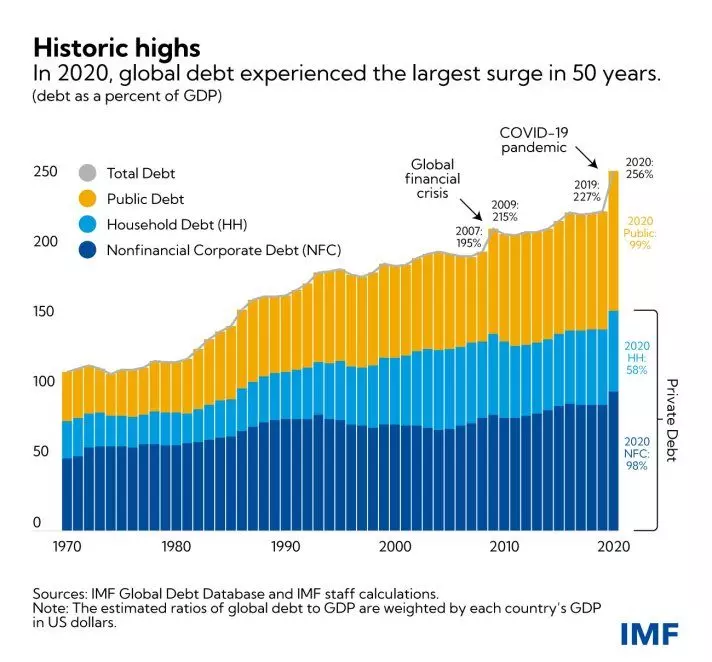Comments
- No comments found

Global debt as a share of GDP rose to an all-time high in 2020, according to the latest update of the IMF’s Global Debt Database.
Here’s a descriptive figure from an article by Vitor Gaspar, Paulo Medas, and Roberto Perrelli at the IMF showing the overall pattern.

As you can see, global debt jumps from 227% of global GDP in 2019 to 256% in 2020. The authors write:
Borrowing by governments accounted for slightly more than half of the increase, as the global public debt ratio jumped to a record 99 percent of GDP. Private debt from non-financial corporations and households also reached new highs. … Advanced economies and China accounted for more than 90 percent of the $28 trillion debt surge in 2020.
You can also see in the figure the comparable jump in debt of 20 percentage points during the Great Recession from 2007-9. The rise in debt as a share of GDP in 2020 has already risen from 2007-9, and one suspects the number will rise even higher in 2021.
The gradual rise in global debt over the decades should probably be viewed as a good thing. There is a natural pattern that debt tends to rise as the financial sector of an economy becomes more developed. After all, low-income countries with few banks and tiny bond markets tend not to have much borrowing and lending.
But after two booms in global debt in the last 14 years–once in the Great Recession and now in the pandemic recession–also brings some constraints and vulnerabilities. If interest rates rise around the world, debtors who borrowed using adjustable rate loans, or who have been planning to roll over their old fixed rate loans with new borrowing, will find that their costs are much higher. Debt is often not that flexible, and so an inability to make payments on past loans, or to afford the borrowing for new roll-over loans, can lead to threatened defaults and forced reorganizations. The authors write: “But the debt surge amplifies vulnerabilities, especially as financing conditions tighten. High debt levels constrain, in most cases, the ability of governments to support the recovery and the capacity of the private sector to invest in the medium term.” Also, high debt levels mean that inflation becomes more attractive to governments and other borrowers, because it allows them to repay past borrowing in cheaper inflated dollars.
During a global financial crisis or a pandemic recession, it can make sense for governments and others to borrow heavily for a year or two. But such rises in debt should be viewed as a short-term palliative, with costs and risks and tradeoffs.
Timothy Taylor is an American economist. He is managing editor of the Journal of Economic Perspectives, a quarterly academic journal produced at Macalester College and published by the American Economic Association. Taylor received his Bachelor of Arts degree from Haverford College and a master's degree in economics from Stanford University. At Stanford, he was winner of the award for excellent teaching in a large class (more than 30 students) given by the Associated Students of Stanford University. At Minnesota, he was named a Distinguished Lecturer by the Department of Economics and voted Teacher of the Year by the master's degree students at the Hubert H. Humphrey Institute of Public Affairs. Taylor has been a guest speaker for groups of teachers of high school economics, visiting diplomats from eastern Europe, talk-radio shows, and community groups. From 1989 to 1997, Professor Taylor wrote an economics opinion column for the San Jose Mercury-News. He has published multiple lectures on economics through The Teaching Company. With Rudolph Penner and Isabel Sawhill, he is co-author of Updating America's Social Contract (2000), whose first chapter provided an early radical centrist perspective, "An Agenda for the Radical Middle". Taylor is also the author of The Instant Economist: Everything You Need to Know About How the Economy Works, published by the Penguin Group in 2012. The fourth edition of Taylor's Principles of Economics textbook was published by Textbook Media in 2017.
Leave your comments
Post comment as a guest